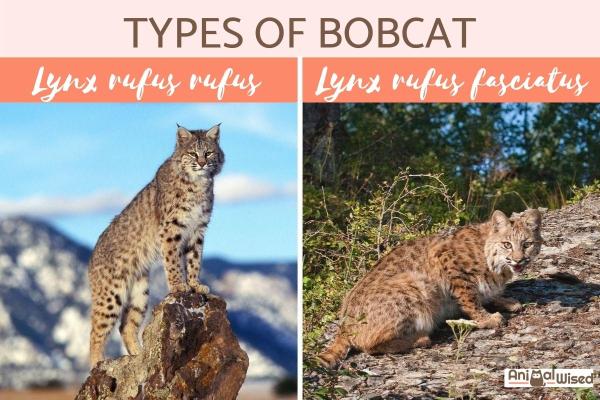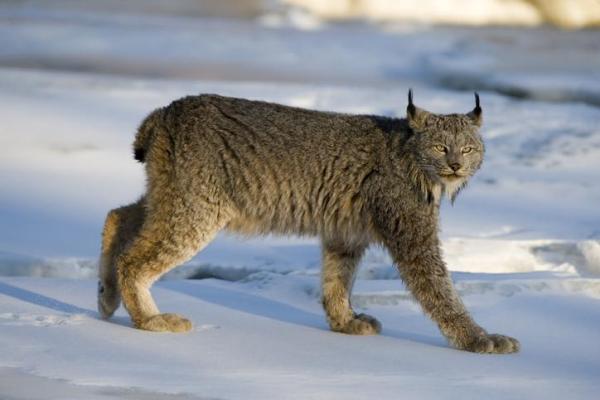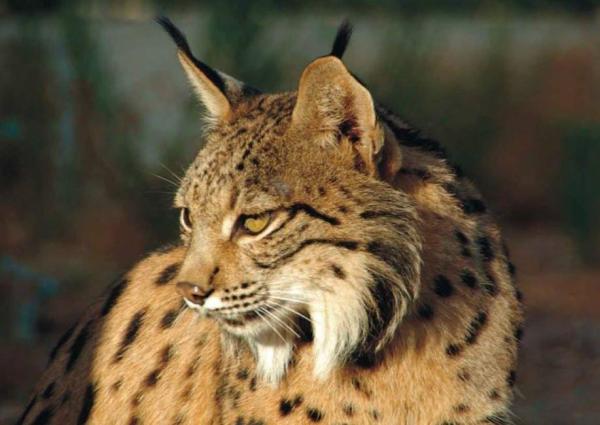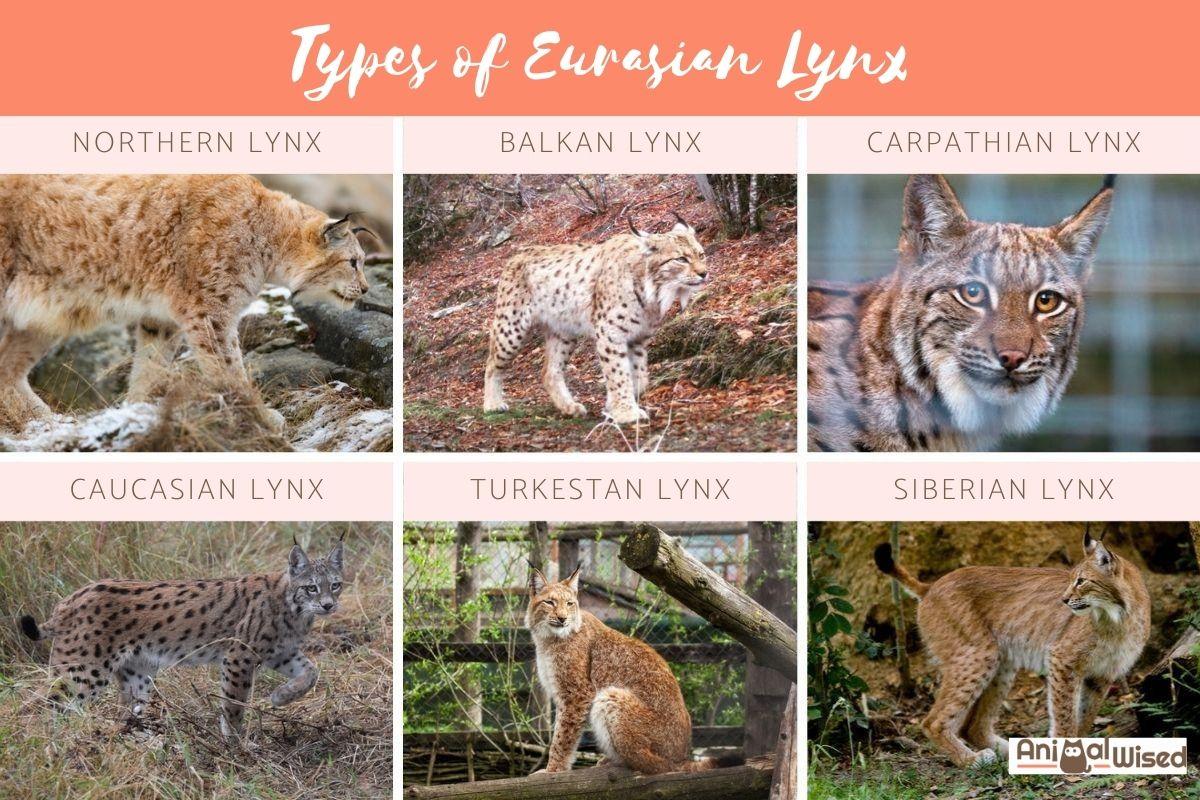All Types of Lynx Species with Characteristics


Although we know there are many different breeds of domestic cat, we are often not as familiar with wild cat breeds. Some may be aware of the differences between a Bengal and Siberian tiger, but knowing the different types of lynx might not be as common knowledge. As with all big cats, lynxes are part of the Felidae family, a group of carnivorous animals which also includes domestic cats. More specifically, they are in the genus also known as Lynx. Although lynxes share similarities with other cats, they also have characteristic differences.
In this AnimalWised article, we share these characteristics by looking at all types of lynx species. We show you some of the specific characteristics of different types of lynx species and provide photos so you can better tell them apart.
How many species of lynx are there?
When we want to know how many different lynx species there are, we need to be aware that the current number of lynx species is different to the total. At the moment, there are 4 known extant lynx species which are:
- Bobcat (Lynx rufus)
- Canadian lynx (Lynx canadensis)
- Eurasian lynx (Lynx lynx)
- Iberian lynx (Lynx pardinus)
These four species are the only living lynx species of which science is aware. We do know of two other species which we can identify as lynx from fossil records. They are Lynx issiodorensis (Issoire lynx) and Lynx thomasi, and it is believed that all lynx species derive from Lynx issiodorensis.
General characteristics of lynxes
Before we look at the individual lynx species, we want to take a look at the general characteristics which all lynx species share, i.e. what makes a lynx a lynx. All lynx types are medium-sized felines and ar characterized by their short tail which is between 10 and 20 cm in length. Also, their ears are particularly long and pointed.
A black ‘plume’ of hair emanates from the lynx's ears. It is very characteristic of the lynx species and can be seen in a few other feline species such as the caracal (Caracal caracal). It can also be seen in some domestic cat breeds with tufted ears such as the Norwegian Forest Cat or Maine Coon.
The tufts of hair in the lynx's ears are not simply decoration. They help them to pick up sounds over very long distances and help to camouflage in their environment. Together with their tabby type cat patterns, they help to make them very stealthy hunters. Their favorite prey are other mammal species such as rabbits. They usually hunt at twilight or at night. Not only are they nocturnal animals, but they are solitary and very territorial.
Unlike other cat species, lynxes are usually monogamous. They are also known to exhibit polygyny, i.e. the male may guard the territory of several females. This is reflected in their sexual dimorphism, with males being larger than females by about 30%. Both sexes can live between 10 and 24 years, with the largest species living the longest.
Now we know a little about the characteristics all lynxes have in common, we look at the different species to see how they are differentiated.

Bobcat (Lynx rufus)
The bobcat is also sometimes known as the red lynx. They are distributed in North America, encompassing Southern Canada, the USA and large parts of Mexico. Their habitat consists of various ecosystems, including forests, scrub land and even deserts. It is likely this diversity of terrain which makes them such opportunistic predators. Although they have a varied diet, their main prey are hares. They can eat rodents, birds, possums and some types of small ungulates.
All types of lynx have a shorter tail which is referred to as ‘bobbed’, but the bobtail's has a white-bottomed tail with black lines. This bobbed tail is where their name comes from. It is often confused with the Canada lynx as they partially share territory. However, the bobcat has shorter ear tufts, shorter legs and smaller feet.
The bobcat's fur is varied in color, depending on the region where they live. You can find brown, yellowish, beige, reddish, gray and even albino individuals.Their size also varies considerably. Individuals from the north are generally larger than those from the south, with males being able to reach about 40 lbs (18.3 kg) in weight. There are various claims of bobcat subspecies, but only two are generally considered accuarte:
- Lnx rufus rufus: east of the Great Plains of North America.
- Lynx rufus fasciatus: wets of the Great Plains of North America.

Canadian lynx (Lynx canadensis)
The Canadian lynx inhabits the boreal forests of Canada, Alaska and the northern United States. Within these forests it is common to see it in clearings, bushy areas and pastures. This is where American hares (Lepus americanus) live in abundance. It is their main prey and accounts for between 60 and 97% of their diet. They complement this diet with birds and rodents, mainly squirrels.
They are a lower weight lynx, weighing only about 12 kg (26.5 lbs). Their rear legs stand out among their specific characteristics. They are much longer than the front legs, so its back is raised and slopes from front to back. Their fur is denser than that of the bobcat. They also have relatively larger feet and abundant hair between the paw pads. Their feet act like snowshoes, so they can easily move through deep snow fall.
As in the previous lynx species, the coat of the Canadian lynx can have several shades, usually reddish brown or grayish brown. They are rarely albinos. They may also have dark spots, although they are less noticeable than in other types of lynx. In their ears, the black border stands out, similar to the black tip which ends on their tail.

Eurasian lynx (Lynx lynx)
The Eurasian lynx or boreal lynx is distributed throughout Europe, Asia and the Middle East. Normally, they live in forests, although they can be found in bushy areas and even steppes. In these places, it feeds on medium-sized ungulates , such as roe deer, chamois or reindeer. They make up around 80% of their diet but, when they are scarce, they can eat hares, wild boars, birds and even foxes.
Our article on unique steppe animals shows some of the other animals which can live in these areas.
They are specialized hunters and the largest of all the different lynx species. They can weigh up to 25 kg (55 lbs) and measure 3.9' (1.2 m) in length. Their tail is also longer than all other lynx with the longest recorded at around 9" (23 cm). They have wide feet which grow extra fur in winter to protect against the cold. They also act as snowshoes.
The Eurasian lynx can be reddish, gray or even yellowish in color, although they have a white chest and belly. They are normally covered in dark spots, although they are not present in every individual.
The distribution of the Eurasian lynx has various fragmented populations, leading to the recognition of 6 different lynx subspecies:
- Northern Lynx (Lynx lynx lynx): northern Europe and western Siberia.
- Balkan lynx (Lynx lynx balcanicus): Balkans.
- Carpathian lynx (Lynx lynx carpathicus): central and eastern Europe.
- Caucasian lynx (Lynx lynx dinniki): Caucasus, Turkey, Iran and Iraq.
- Turkestan lynx (Lynx lynx isabellinus): Central Asia.
- Siberian lynx (Lynx lynx wrangeli): eastern Russia and China.

Iberian lynx (Lynx pardinus)
The Iberian lynx is endemic to the Iberian Peninsula. At the beginning of the 20th century, this feline was very abundant in much of Spain and Portugal. However, today it is in danger of extinction. Although they have been introduced elsewhere, there are only two stable populations: one in Doñana and the other in Sierra Morena (Andalusia). Their ecosystem is still preserved in shrub land where they hunt rabbit and other animals of the Iberian peninsula.
The European rabbit (Oryctolagus cuniculus) represents more than 80% of their diet, so the Iberian lynx is completely dependent on its existence to survive. Their hunting strategy is based on stalking. They hide in the bushes and only usually need to launch a few meters towards their prey. They are very efficient hunters thanks to their size, with a maximum weight of 28.5 lbs (13 kg) in males. Their entire body is covered by brown or tawny fur, with highly variable dark spots.
Their head is quite small, as with other types of lynx. On both sides of their face are black and white locks that form a very noticeable beard. They have beautiful greenish-yellow eyes, surrounded by a black line. Their tail measures about 5.5 " (14 cm) and ends in a black tip.
If you want to read similar articles to All Types of Lynx Species with Characteristics, we recommend you visit our Facts about the animal kingdom category.
- IUCN Cat Specialist Group. Bobcat ( Lynx rufus ). At: catsg.org. IUCN Cat Specialist Group. Cat News .
- IUCN Cat Specialist Group. Canada lynx ( Lynx canadensis ). At: catsg.org. IUCN Cat Specialist Group. Cat News .
- IUCN Cat Specialist Group. Eurasian lynx ( Lynx lynx ). At: catsg.org. IUCN Cat Specialist Group. Cat News .
- Kitchener, AC, Breitenmoser-Würsten, C., Eizirik, E., Gentry, A., Werdelin, L., Wilting, A., ... & Duckworth, JW (2017). A revised taxonomy of the Felidae: The final report of the Cat Classification Task Force of the IUCN Cat Specialist Group . Cat News.
- LIFE + IBERLINCE. Historical and current distribution of the Iberian lynx . In: iberlince.edu. LIFE10NAT / ES / 570 . Recovery of the historical distribution of the Iberian lynx ( Lynx pardinus ) in Spain and Portugal.
- Rodríguez, A. (2017). Iberian lynx - Lynx pardinus . In: Virtual Encyclopedia of Spanish Vertebrates . Salvador, A., Barja. I. (Eds.). National Museum of Natural Sciences, Madrid.
- Rodríguez, A. & Calzada, J. 2015. Lynx pardinus (errata version published in 2020). The IUCN Red List of Threatened Species 2015: e.T12520A174111773. Downloaded on 14 September 2020.






 is there any way to make manythings for this cat and spend money to have lynx pet and try to make it like normal cat
is there any way to make manythings for this cat and spend money to have lynx pet and try to make it like normal cat





